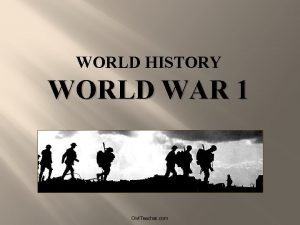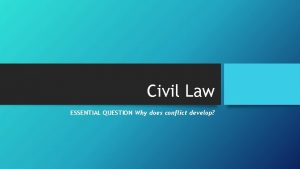Early Campaigns Why does conflict develop Early Campaigns









- Slides: 9

Early Campaigns Why does conflict develop?

Early Campaigns Guiding Question: What were significant battles in the early years of the American Revolution? • Relatively few soldiers fought in the war's early battles. • At Bunker Hill, for example, about 2, 200 British soldiers fought 1, 200 Americans. • The British had not yet won a clear victory. They realized they were going to need more troops. During the summer of 1776, Britain sent 32, 000 troops across the Atlantic to New York. • The British commander, General William Howe, hoped the sheer size of his army would convince the Patriots to give up. • He was soon disappointed.


Patriot Defeat on Long Island Only 20, 000 soldiers made up the Patriot force under George Washington. The two sides clashed in the Battle of Long Island in late August 1776. • The British badly defeated the outnumbered Continental Army. • One Patriot, Nathan Hale, showed his bravery at Long Island. Hale disguised himself as a Dutch schoolteacher and went to spy on British troops. The British caught Hale and hanged him as punishment. According to legend, Hale went to his death saying, "I only regret that I have but one life to lose for my country. ” • The Patriots fought hard on Long Island but could not overcome the larger and better-equipped British army. • A British officer wrote that many Patriot soldiers killed on Long Island had not been wearing shoes, socks, or jackets. • After the defeat, Washington retreated from New York, which became a Loyalist stronghold. The British chased the Continental Army across New Jersey into Pennsylvania. Satisfied that Washington was beaten, the British let him go.

A Low Point for the Patriots Washington and his forces had managed to escape the British. • As winter approached, however, the Patriots' cause was near collapse. • The Continental Army had fewer than 5, 000 soldiers. Many had completed their terms. Others had run away. • Washington wrote his brother that if new soldiers were not found soon, “I think the game is pretty near up. ” Yet he remained hopeful that the fight for freedom would succeed. • Washington begged the Continental Congress for more troops. He suggested allowing African Americans to enlist, but many Americans opposed this idea. • Early in the war, the Southern Colonies had persuaded the Congress not to take this step. • Many white people in the South worried about giving guns and training to African Americans. • They feared the possibility of revolt among the enslaved population.

African Americans in Battle The growing need for soldiers led some states to ignore the ban on African Americans. • By the war's end, every state except South Carolina enlisted African Americans to fight. • Historians believe that as many as 5, 000 African Americans joined the Patriots. • African Americans had many reasons to fight. • Some fought because they believed in the Patriot cause. • Others may have joined up for the chance to earn money. • Some were enslaved Africans who had run away or who were allowed by their owners to enlist. • Some wanted freedom.

The Battles of Trenton and Princeton While the Patriots were struggling through the winter, the main British force was settled in New York. • The British also left some troops in Princeton and Trenton, New Jersey. • Washington saw a chance to catch the British by surprise. Washington was camped in Pennsylvania, across the Delaware River from the British camp in New Jersey. • On Christmas night 1776, Washington led 2, 400 troops across the icy river to surprise the enemy at Trenton the next day. • Washington then escaped and marched to Princeton; his army scattered the British force there.

British Strategy Guiding Question: Was the British plan for victory successful? In early 1777, the British began a three-pronged battle plan. • Their goal was to seize Albany, New York, and gain control of the Hudson River. • If they controlled the Hudson, they would cut off New England from the Middle Colonies. First, General John Burgoyne would lead troops south from Canada. • At the same time, Lieutenant Colonel Barry St. Leger would move east from Lake Ontario. • A third group, under General Howe, would move north up the Hudson. • The three British forces would then attack Patriot troops at Albany.

The British Capture Philadelphia Before the attack on Albany, Howe sought to capture Philadelphia—the home of the Continental Congress. • Howe won battles in September 1777 at Brandywine and Paoli, near Philadelphia. • Then Howe's troops captured Philadelphia, forcing the Continental Congress to flee. • By now, winter was coming. • Howe decided to stay in Philadelphia instead of going to Albany.
 Why does conflict develop?
Why does conflict develop? Pictures
Pictures Why did a stale- mate develop on the western front?
Why did a stale- mate develop on the western front? Why did a stale- mate develop on the western front?
Why did a stale- mate develop on the western front? Coaching is a relationship where the coach helps a marine
Coaching is a relationship where the coach helps a marine Locusts things fall apart
Locusts things fall apart What claim does girard develop in this essay?
What claim does girard develop in this essay? Dont ask
Dont ask Public communication meaning
Public communication meaning Com3701
Com3701
















